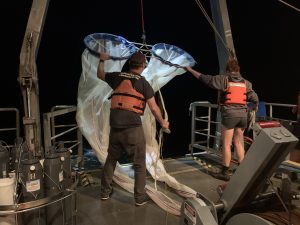Adventures in the Gulf of Maine – Part 4(!)
This is the last of four posts about our field campaign in the Gulf of Maine during Spring/Summer 2023.
This field campaign was harder than I had expected, but we could finally see the finish line. We just needed to make one last trip to sample an inshore station and round out our data set.
Becky, Phil and I met up with the crew of the Gulf Challenger, left the dock around 7:30 pm and were on station before 8. The weather was overcast and choppy…by now I had resigned myself to seasickness. We quickly conducted a CTD cast and got all the water we needed for various analyses, experiments, and for transporting zooplankton back to the lab. The surface water was warm (up to about 20°C, nearly 70°F) and there was a strong shallow bloom. We did a couple of tows, pulled in a good haul of zooplankton and headed back to the dock.
choppy…by now I had resigned myself to seasickness. We quickly conducted a CTD cast and got all the water we needed for various analyses, experiments, and for transporting zooplankton back to the lab. The surface water was warm (up to about 20°C, nearly 70°F) and there was a strong shallow bloom. We did a couple of tows, pulled in a good haul of zooplankton and headed back to the dock.
In the lab, Phil and I quickly got to work picking zooplankton. It took us less than an hour to find all the Centropages typicus we needed. Then the hunt was on for Calanus finmarchicus females. Calanus is generally less abundant at this inshore site, and females are less common this late in the summer. So, that all goes to say that we searched until around 4 am and ended up with a total of 14 Calanus females (we were hoping for 30, but eventually admitted defeat). Of the 14, two had apparent ectoparasites.
After a few hours of sleep and a hearty diner meal, Phil headed back to Woods Hole. I stayed to take down the experiments…my first time doing it solo. I headed into the lab around 10 pm and hung out for a couple of hours until it was time to start counting. At the stroke of midnight, I started processing the Calanus. Half of the animals had produced some eggs, which seemed like a reasonable observation. The Centropages were more problematic. About half of the animals we had incubated seemed to be dead and none of the incubations produced any eggs. I packed up all of our stuff in the very large WHOI truck around 3 am and headed back to Woods Hole.
Something had clearly gone wrong with our experiments. I’m a little surprised by this because our transport time was relatively short and we were able to pick the Centropages fairly quickly. It seems like they got overcrowded or too warm or….something…at some point in our incubations. It’s frustrating because we worked really hard to collect those data, and it doesn’t seem like we can trust them.
So on to plan B. We have formalin-preserved samples from each of our cruises. We won’t be able to assess egg production rates from those samples, but we should be able to stain the animals and assess their level of reproductive development. Over the past few weeks, we have been reviewing protocols, ordering supplies and setting up equipment. We are just about ready to get started and are hoping to have some answers this fall.
I have some mixed feelings about this summer field program. We worked really hard and have some interesting samples to work with, but we just weren’t able to do everything we had hoped for. I’ve learned a lot about field logistics, particularly how extremely valuable it is to have experienced technical assistance. We absolutely could not have done this work without Phil!